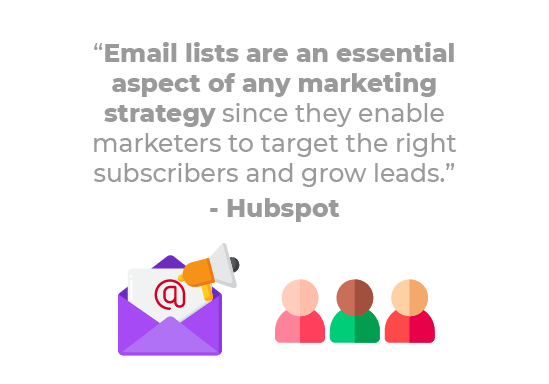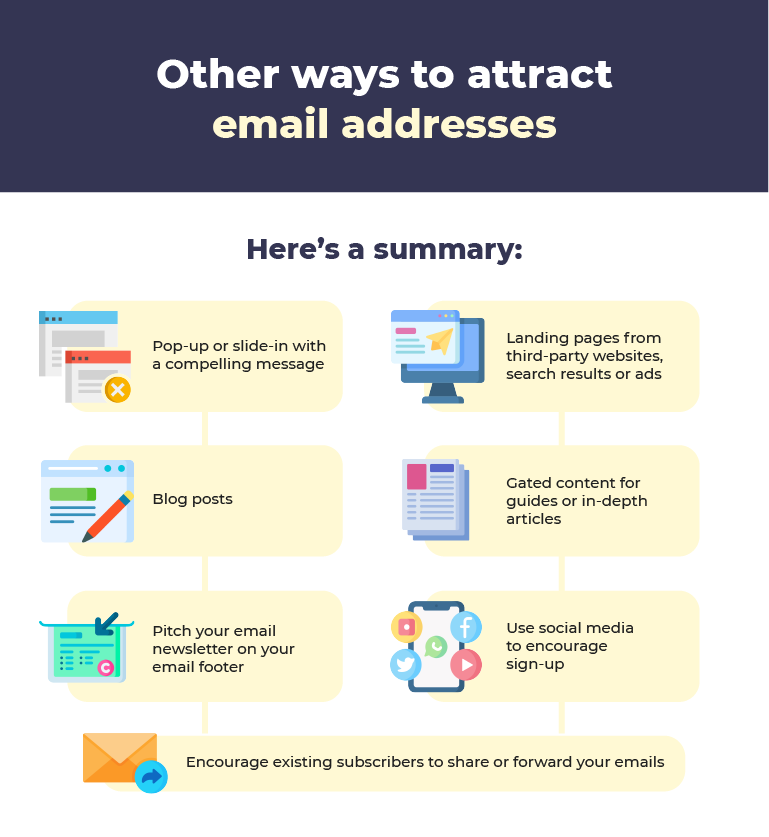- What is an email list?
- How can small businesses benefit from generating an email list?
- How can small businesses grow and manage email lists?
Q: How can small businesses generate more business leads through email lists?
A: Small businesses can generate more leads by building an effective email list of clients and prospects that are interested in their solutions and sending them engaging content that is relevant to the industry and their company.
What’s one of the most powerful and cost-effective small business marketing tools?
You guessed it: email marketing.
Email marketing provides an average return on investment of $42 for every $1 spent, making it one of the best performing marketing channels available.
But before you can create high-performing email campaigns, you need an email list.
Quite simply, an email list for marketing is a collection of email addresses.
You can build an email list yourself by encouraging people to provide their email address through a form on your website, at an event, an affiliate landing page, or various other means.
Once they have given you their email address, subscribers expect to receive information, updates, discounts, or other such details about your business directly to their email inbox.
These people are tuned-in, ready and waiting for information from your brand.
And that’s why email lists are so valuable.
“Email lists are an essential aspect of any marketing strategy since they enable marketers to target the right subscribers and grow leads.” – Hubspot
You might be thinking, why? Who wants to get bombarded by emails every day?
In today’s digital landscape, direct connection is everything.
Consumers want brands to come to them, and they expect to be updated automatically rather than having to seek out new products or services.
There’s a lot of marketing ‘noise’ out there. Information overload is real, and as a consumer, sometimes it’s a lot easier to receive targeted, interesting content direct to your inbox rather than wading through search engine results, ads, and social media posts.
Key to that is creating, and nurturing, the right email list.
Good news is, building an email list isn’t difficult or expensive.
There are various ways to attract email subscribers and grow your email list, which we’ll explain in this guide.
We’ll also dip into the benefits of email lists, how email marketing can help your business grow stronger, and tips to keep your valuable email subscribers tuned in and engaged.
Ready to learn more about email lists?
Let’s get started.
What is an Email List?
An email list is a running list of email addresses gathered from any number of lead-generating sources and strategies.
Your own email address is probably on dozens of different email lists.
Every time you put your email address into a form and tick the consent box, your email address is joining a marketing email list. It might be related to your business, or it could be for something personal — like your favourite local coffee shop.
Once your email is in that list, it may be segmented. This means you are grouped according to certain parameters (such as preferences or interests) and then added to a ‘sub-list’.
This is a good thing. It means you are more likely to receive targeted content that’s relevant and useful.
Now think about how your own business could benefit from having an email list.
Essentially, it allows you to mass email a wealth of leads, informing them of new developments. This keeps your brand relevant in the minds of your consumers and helps ensure they don’t lose interest.
In short, a carefully maintained email list, combined with the right content, can be fundamental to business growth.
What Benefits are Gained from Having an Email List?
60% of consumers say they’ve made a purchase as the result of a marketing email they received. That’s compared to 12.5% of consumers who buy through social media.
Email marketing can be incredibly powerful.
But there’s more to a successful campaign than simply writing an engaging email. It’s about who you send it to — and that’s why your email list is so important.
How Can Small Businesses Grow and Manage their Email Lists?
How do I create an email list?
The easiest way to create an email list is to use an email list service. Here are some popular and easy-to-use email list platforms for SMBs:
- Mailchimp
- Constant Contact
- SendinBlue
- AWeber
- GetResponse
Here we’ll explore some tried-and-tested ways to build and maintain your email marketing list.
Building Your Email List from Scratch
How do I get people to join my email list?
Using a landing page or a blog post on your website with a strong call to action is a great way to get people to sign up for your email list.
You can generate traffic to landing pages and blog posts from a variety of sources — such as search engine results, social media ads, affiliate articles, or other third party content.
Once a user lands on your blog or landing page, direct them to a sign-up form with a customized message. The message on your form should be adapted to the landing page subject (for instance, sales techniques), or the purpose (learn how to increase sales).
If you have a particularly in-depth blog post or a guide, consider converting it into ‘gated content’. This means you require an email address in order for the reader to access the full article.
Pop-ups and slide-ins also entice users to sign up.
According to one study, users saw their list growth rate increase by an average of 50.8% after adding a pop-up form to their site.
It’s important to keep your pop-up content short and concise, and give a compelling reason to sign up. For instance: ‘Learn how to increase sales revenue with our simple 3-step guide. Get yours here!’
Of course pop-ups can be annoying, especially when the message is irrelevant. Consider using timed pop-ups that act on how long the user has been on the site, or on their browsing behavior.
For instance, tracked links ensure that people who visit your website from your newsletter won’t see the pop-up, because they’re already a subscriber.
Those viewing product pages or moving through the sales funnel shouldn’t receive a pop-up (unless it’s directly related to a product) because it could distract their purchase decisions.
Add Value with a Powerful Call-to-Action
One of the key factors in successfully gaining leads is ensuring your call to action (CTA) is targeted and impactful.
It should make the viewer want to join the email list.
In today’s era of information overload, a simple ‘Click here’ won’t cut it.
Customize your CTA to entice readers to take that next step.
Add a sense of urgency, such as ‘Buy Now!’ or capitalize on our natural fear of missing out with phrases such as ‘Last Chance’ or ‘Ends Tomorrow’.
Above all, use your CTA to add value.
When writing a CTA, always ask ‘Why?’
A button that says simply ‘Sign Up’ doesn’t answer the ‘Why should I?’ question. There’s no obvious value.
Instead, a button that says ‘Gain Exclusive Access’ or ‘Get Your Free Gift’ gives a reason to subscribe. Your reader knows they are getting something exclusive simply in exchange for providing their email address.
If you’re wondering, is it illegal to buy email lists?
Don’t even think about it.
Buying email lists can be illegal. It’s a violation of GDPR and the CAN-SPAM Act.
Even if the seller claims that the list is “Opt-In” or “Verified,” you have no idea what content the subscribers first signed up for. This post explains the dangers in full.
Maintaining Your Email List and Keeping Subscribers
Once you’ve started gaining subscribers, the next challenge is to keep them.
The idea is simple: Provide what they signed up for.
The aim of email list management is to nurture your subscribers. By keeping them engaged with your content, they’re more likely to stay subscribed to your emails.
Whether that’s exclusive content, special discounts, or interesting news, you need to fulfil your promise and deliver relevant content in a timely manner.
First, create a strong and friendly welcome email.
Once they join your email list, the subscriber should be greeted by an email that engages their interest and reminds them why they subscribed.
76% of people expect to receive a welcome email immediately after subscribing to your list.
Your first email is arguably your most important. Use it to connect with your new subscriber and give them one or more reasons to stay.
Reaffirm their reason for signing up, and if they are expecting an exclusive download or a product code, now is the time to deliver it.
Include instructions on how to activate it, and FAQs or contact information in case they require help or support.
But don’t stop there.
Use your welcome email to connect with your subscribers, demonstrate your brand promise, and summarize the benefits your products or services can offer.
There is always more value you can offer your subscribers.
You can include links to enticing content, an exclusive offer, or a list of quick tips to help them get started.
Next, send consistent content.
After your initial welcome email, you can begin sending regular, customized content to your subscribers.
The aim is to keep your brand top of mind. With every email you send, your objective is for subscribers to want to reach for it and feel excited about the content inside.
To do this, your content should be relevant and engaging.
Remember to focus on keeping it tuned to what your subscribers expect. Whether it’s the latest news or exclusive discounts, by delivering on your promise consistently, your subscribers will remain loyal.
If your list is large and varied enough, you may want to segment it.
This could be as simple as segmenting into ‘existing clients’ and ‘leads’.
Or, depending on your product range you could segment further and create customized content by location, age, interests, or other demographic data.
A good email marketing platform will enable you to easily create segments within your email list.
Ultimately, segmenting your email list allows you to reach different niches with content better suited to their wants and needs.
Best Time of the Week to Send Emails
What time do people check their emails the most?
Although it’s not an exact science, research suggests that 10am and 1pm typically have strong open and click rates.
Generally, research suggests that Tuesdays, Wednesdays and Thursdays are the best days to send emails.
Friday is generally the least effective, but it’s still considered a better day to send than Saturday or Sunday.
Remember though, it depends on factors such as your audience demographics, behaviors, and also your industry.
Find out for yourself by sending emails on different days, analyzing the results, and testing again.
Most email marketing platforms provide analytics that will help you drill down into the data.
Creating Content for Email Subscribers
Now for the big topic: What should I send my subscribers?
Before you do anything, create a content calendar for your email marketing campaigns. It can be a simple spreadsheet containing:
- Send date
- Email list or segment
- Topic
- Main CTA (where will you send readers?)
Even if you only send one email per week, your calendar will provide visibility over your email schedule to help ensure your content is timely, relevant, and well balanced.
Next, start to populate your calendar with topics.
Every time you create email content, think about its purpose.
What value will it bring to your subscribers?
Let’s take the example of No.12 in the above list: Team bios and stories.
Storytelling is all about capturing the humanness of your team, your company, and your vision. Within your email, provide a glimpse into the lives of one of your people.
You and your people are all unique. What stories can you tell? How did you get here? What accomplishments have you made in your lifetime?
Stories build connections, engage the reader, and show that you’re human — not a faceless company.
Your email should provide a short glimpse into the beginning of your story. A click-through button with an enticing CTA will take the reader to your website to continue reading.
List Analysis and Cleaning
What is a good email list?
A good email list is one which has a high conversion and increases traffic to your desired destination (typically your website, product pages, or booking form).
If your email list is growing but your open and click-through rates remain stubbornly low, it’s probably time to clean up your email list.
Noticing who is joining and who is leaving your email list will give you valuable insights into who you should target, and where you might need to change your approach.
By regularly analyzing and ‘cleaning up’ your list, it will enable you to improve engagement.
A list that’s full of outdated or invalid email addresses will result in email bounces and spam complaints, which can impact your ability to reach your subscriber base.
You can deal with email bounce backs manually, or as your list grows, you can use an email verification tool to speed up the process.
Some verification tools include ZeroBounce, Mailfloss, MailerCheck, EmailListVerify and Clearout.
These tools scan and verify your email list and remove invalid emails, resulting in a higher deliverability rate.
A Word About Disengagement
Don’t keep ‘sleeper’ subscribers in your email list for too long.
They’re the ones who sit on your email list and delete your emails without reading or engaging with them. Or worse, they simply mark your emails as ‘spam’.
Why don’t they unsubscribe?
There could be various reasons. Perhaps the unsubscribe process isn’t clear enough. Or maybe the email goes into their spam folder, unnoticed.
Or perhaps they simply aren’t taking the time to unsubscribe — this is more common than you might think.
Regardless of the reason, you need to act.
- Notify unengaged subscribers that you miss them, and offer them the chance to re-opt in. Wait a couple of weeks and then remove them if they don’t re-subscribe.
- Make your ‘unsubscribe’ process obvious and easy to follow.
- On your ‘unsubscribe’ form, ask for optional feedback on why they are leaving. Offer 4 or 5 multiple choice reasons and a comment box.
Why not just keep ‘sleeper’ subscribers?
If they’re no longer interested, you are wasting time and money by communicating with them.
Worse, if recipients feel like they can’t leave because the unsubscribe feature isn’t clear enough, they’ll get frustrated and mark your emails as spam.
This counts as a big strike against your sender reputation.
When recipients report your emails, ISPs (Internet Service Providers) lose confidence that your emails are of any value, which means that they may block or filter your emails out for other recipients’ inboxes as well.
So, by removing ‘sleeper’ subscribers, you’re doing everyone a favor.
Conclusion
Email marketing is a powerful marketing tool for small businesses.
Thanks to the wide variety of email management platforms available, building and managing your own email list isn’t difficult or expensive.
Small businesses can use their email lists to generate engagement, increase conversions and grow with relatively little cost.
We hope this guide has helped you to understand how to start and build an email list. Why not connect with us on Twitter and Facebook and share your email marketing insights?
Further Reading






















